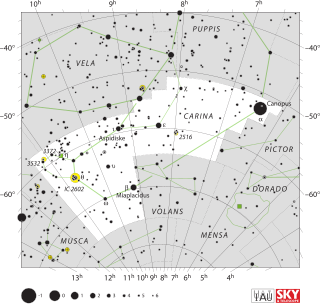
Carina is a constellation in the southern sky. Its name is Latin for the keel of a ship, and it was the southern foundation of the larger constellation of Argo Navis until it was divided into three pieces, the other two being Puppis, and Vela.
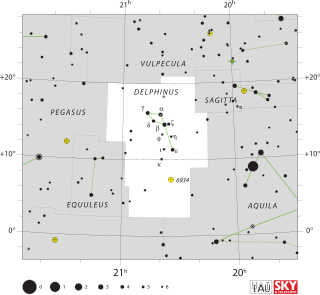
Delphinus is a small constellation in the Northern Celestial Hemisphere, close to the celestial equator. Its name is the Latin version for the Greek word for dolphin (δελφίς). It is one of the 48 constellations listed by the 2nd century astronomer Ptolemy, and remains one of the 88 modern constellations recognized by the International Astronomical Union. It is one of the smaller constellations, ranked 69th in size. Delphinus' five brightest stars form a distinctive asterism symbolizing a dolphin with four stars representing the body and one the tail. It is bordered by Vulpecula, Sagitta, Aquila, Aquarius, Equuleus and Pegasus.

Cepheus is a constellation in the deep northern sky, named after Cepheus, a king of Aethiopia in Greek mythology. It is one of the 48 constellations listed by the second century astronomer Ptolemy, and it remains one of the 88 constellations in the modern times.
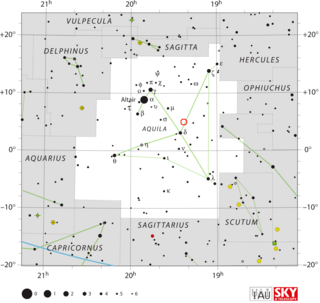
V1494 Aquilae or Nova Aquilae 1999 b was a nova which occurred during 1999 in the constellation Aquila and reached a brightness of magnitude 3.9 on 2 December 1999. making it easily visible to the naked eye. The nova was discovered with 14×100 binoculars by Alfredo Pereira of Cabo da Roca, Portugal at 18:50 UT on 1 December 1999, when it had a visual magnitude of 6.0.
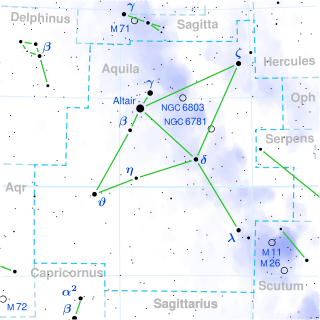
Eta Aquilae is a multiple star in the equatorial constellation of Aquila, the eagle. It was once part of the former constellation Antinous. Its apparent visual magnitude varies between 3.49 and 4.3, making it one of the brighter members of Aquila. Based upon parallax measurements made by the Gaia spacecraft on its third data release (DR3), this star is located at a distance of roughly 272 parsecs. The primary component is a Classical Cepheid variable.

Gamma Aquilae, Latinized from γ Aquilae, and formally known as Tarazed, is a star in the constellation of Aquila. It has an apparent visual magnitude of 2.712, making it readily visible to the naked eye at night. Parallax measurements place it at a distance of 395 light-years from the Sun.
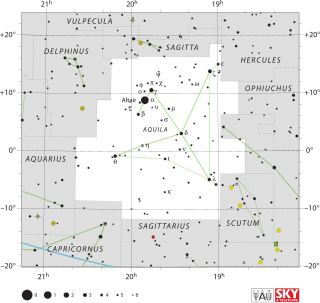
Iota Aquilae, Latinized from ι Aquilae, is the Bayer designation for a star in the equatorial constellation of Aquila. It has the traditional name Al Thalimain, which it shares with λ Aquilae. The name is derived from the Arabic term الظليمینal-ẓalīmayn meaning "The Two Ostriches". With an apparent visual magnitude of 4.364, this star is bright enough to be seen with the naked eye. Based upon an annual parallax shift of 8.34 ± 0.79 mas, it is located at a distance of around 390 light-years from Earth. At that distance, the visual magnitude of the star is diminished by 0.15 from extinction caused by intervening gas and dust.

Omicron Aquilae is the Bayer designation for a double star in the equatorial constellation of Aquila. The brighter component has an apparent visual magnitude of +5.11, which means it is faintly visible to the naked eye in dark suburban skies. The annual parallax shift of this star is 52.11 mas, which is equivalent to a physical distance of 62.6 light-years from Earth.
70 Aquilae, abbreviated 70 Aql, is a single orange-hued star in the equatorial constellation of Aquila. 70 Aquilae is its Flamsteed designation. It is visible to the naked eye with an apparent visual magnitude of 4.90. The distance to 70 Aquilae, as determined from its annual parallax shift of 3.5 mas, is around 940 light years. The star is moving closer to the Earth with a heliocentric radial velocity of −9 km/s.
4 Aquilae, abbreviated 4 Aql, is a single, white-hued star in the equatorial constellation of Aquila. 4 Aquilae is the Flamsteed designation. It has an apparent visual magnitude of 5.02, making it a faint star visible to the naked eye. The distance to 4 Aql can be estimated from its annual parallax shift of 6.7 mas, yielding an estimated range of around 480 light years. It is moving closer to the Earth with a heliocentric radial velocity of −13 km/s.

21 Aquilae is a solitary variable star in the equatorial constellation of Aquila. It has the variable star designation V1288 Aql; 21 Aquilae is its Flamsteed designation. This object is visible to the naked eye as a dim, blue-white hued star with a baseline apparent visual magnitude of about 5.1. The star is located at a distance of around 680 light-years from Earth, give or take a 20 light-year margin of error. It is moving closer to the Earth with a heliocentric radial velocity of –5 km/s.

31 Aquilae is a star in the equatorial constellation of Aquila. 31 Aquilae is its Flamsteed designation though it also bears the Bayer designation b Aquilae. This star has an apparent visual magnitude of 5.16 and is 49.5 light years from Earth. It has no known companions.
14 Aquilae is a probable spectroscopic binary star system in the equatorial constellation of Aquila. 14 Aquilae is the Flamsteed designation though it also bears the Bayer designation g Aquilae. It is visible to the naked eye as a dim, white-hued star with an apparent visual magnitude of 5.42, and it is located at a distance of approximately 500 light-years from Sun. The star is moving closer to the Earth with a heliocentric radial velocity of −39 km/s, and may come as close as 136 light-years in around 3.5 million years.
15 Aquilae is a star in the equatorial constellation of Aquila. 15 Aquilae is the Flamsteed designation; it also bears the Bayer designation h Aquilae. The apparent visual magnitude is 5.41, so it is faintly visible to the naked eye. An optical companion, HD 177442, is 39 arc seconds away from it The distance to 15 Aquilae can be estimated from its annual parallax shift of 11.27 mas, yielding a range of approximately 289 light-years from Earth with a 9 light-year margin of error.

28 Aquilae, abbreviated 28 Aql, is a star in the equatorial constellation of Aquila. 28 Aquilae is its Flamsteed designation though it also bears the Bayer designation A Aquilae, and the variable star designation V1208 Aquilae. It has an apparent visual magnitude is 5.5, making this a faint star that requires dark suburban skies to view. The annual parallax shift of 9.6 mas means this star is located at a distance of approximately 340 light-years from Earth.
58 Aquilae is a single star located around 520 light years from the Sun in the equatorial constellation of Aquila, near Eta Aquilae. 58 Aquilae is its Flamsteed designation. It is visible to the naked eye as a dim, blue-white hued star with an apparent visual magnitude of 5.60. This object is moving closer to the Earth with a heliocentric radial velocity of −53 km/s, and may come as close as 161 light-years in around 1.8 million years.
8 Aquilae is a star in the equatorial constellation of Aquila, located 271 light years away from the Sun. 8 Aquilae is the Flamsteed designation. It can be viewed with the naked eye in good seeing conditions, appearing as a dim, yellow-white hued star with an apparent visual magnitude of 6.08. The star is moving further from the Earth with a heliocentric radial velocity of +12 km/s.

FF Aquilae is a classical Cepheid variable star located in the constellation Aquila, close to the border with Hercules. It ranges from apparent magnitude 5.18 to 5.51 over a period of 4.47 days, meaning it is faintly visible to the unaided eye in rural or suburban settings.

U Aquilae is a binary star system in the constellation Aquila, Located approximately 614 parsecs (2,000 ly) away from Earth.

Omega2 Aquilae, Latinized from ω2 Aquilae, is the Bayer designation for a star in the equatorial constellation of Aquila, the eagle. It has an apparent visual magnitude of 6.0, which is close to the lower limit of detectability with the naked eye. According to the Bortle Dark-Sky Scale, this star can be viewed from dark rural skies. As the Earth orbits about the Sun, this star undergoes a parallax shift of 11.7 mas. This is equivalent to a physical distance of 279 light-years from Earth, give or take a 2 light year margin of error. The star is drifting closer to the Sun with a radial velocity of −26 km/s.












